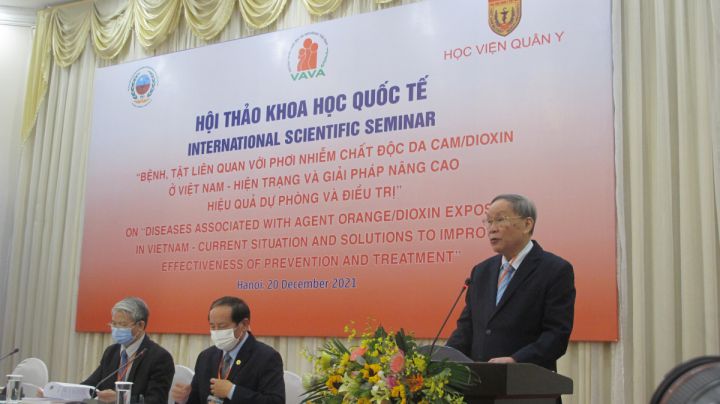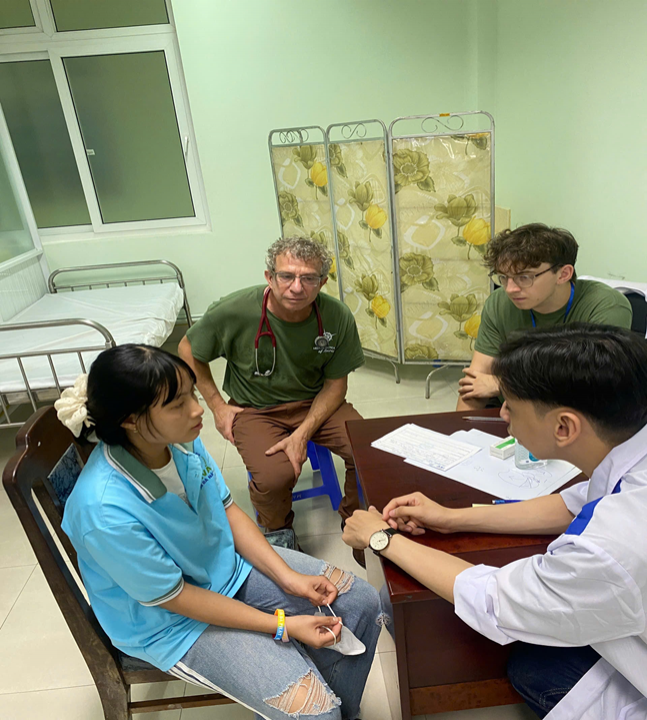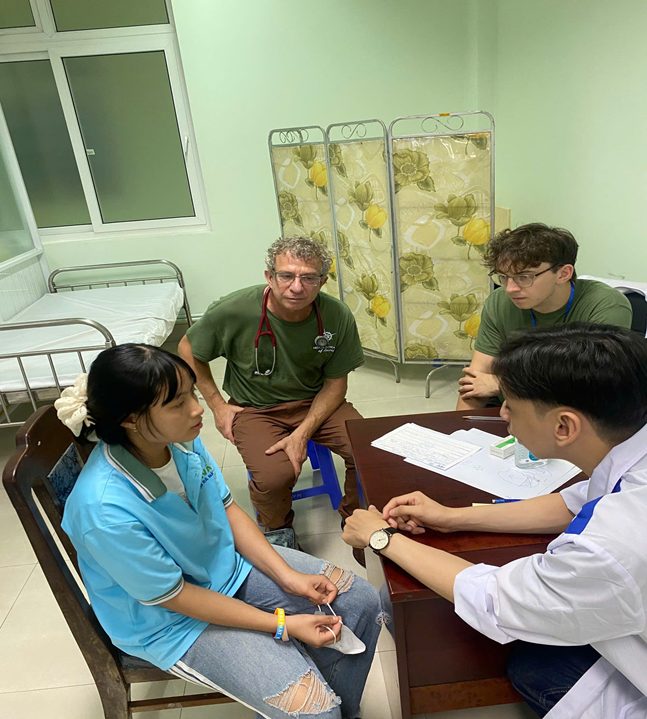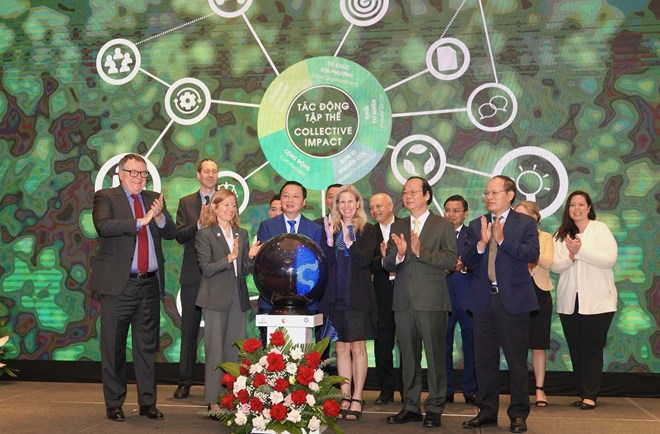 |
1. INTRODUCTION
Even in the US, many veterans and people who have worked in Vietnam related to Agent Orange/dioxin also suffer from cancer, hematopoietic diseases, neurological diseases, quantity and quality decreased sperm count, miscarriage rates of American veterans\' wives, premature babies, and children with malformations were higher than in the control group.
Deeply aware of the dangerous effects of Agent Orange/dioxin on the environment and human health, the Party, State, Government, social organizations, Vietnamese people, and international organizations have there are many specific directives, decisions and actions to deal with the consequences of Agent Orange/dioxin in Vietnam. Successfully treated dioxin at Da Nang airport, currently handling dioxin at Bien Hoa airport, intervened to reduce dioxin exposure through food, organized rehabilitation for Agent Orange victims/ dioxin achieved positive results.
However, the impact of Agent Orange/dioxin on the environment and health in Vietnam is still long-lasting, so health care, early detection of diseases, and timely intervention to reduce suffering for the victims of the disease are very important. is an urgent requirement of the whole society and the health sector.
Over the years, testing work has always accompanied other studies to contribute to the assessment of the impact of Agent Orange/dioxin on the human body. The impact of dioxin on human health is not specific, dioxin can affect many organ systems in the body such as immune system, endocrine system, nervous system, mental health, reproductive health., disrupting metabolism and causing cancer. Decision No. 09/2008/QD-BYT dated February 20, 2008 of the Ministry of Health promulgating a list of 17 diseases, deformities and malformations related to Agent Orange/dioxin exposure in Vietnam [3]. Diagnosing diseases caused by dioxins is not simple. In addition to the history, epidemiology, and clinical examination, tests must be sufficient to contribute to the diagnosis of the disease status of the person exposed to the poison and the generations in their family. In recent years, due to the rapid development of modern, highly sensitive and specific testing methods and techniques, it has allowed to conduct relatively synchronous tests right in Vietnam, helping to improve patient care. health care of Agent Orange/dioxin victims. Some of the reviews are mentioned below.
2. CONTENT
2.1. Tests to assess impact on hematology
Overall analysis of peripheral blood count. This is a simple test that can be performed at the primary health care level. This test allows the assessment of peripheral blood cells, especially red blood cells and white blood cells, which are commonly affected cell lines by Agent Orange/dioxin. If conditions allow, it is recommended to perform analysis of peripheral blood count with many parameters, do hematography, marrow histogram to see more clearly the change in composition and shape of the leukocyte line. Some studies have shown a change in the shape of white blood cells in Agent Orange/dioxin victims.
In medical facilities with specialized medical staff and guaranteed specialized equipment, it is possible to determine the number of CD3, CD4, CD8, CD19 cells (dendrictic cells - dendritic cells) [7].
2.2. Biochemical tests
* Liver function tests:
After entering the body through food and drink (mainly), the liver is the first organ to be affected by Agent Orange/dioxin. Furthermore, Agent Orange/dioxin is eliminated mainly in the faeces via the biliary tract. As an important metabolic organ of the body, the function of the liver can be affected by Agent Orange/dioxin. Liver function tests include: AST (Aspartate transaminase), ALT (Alanine trasaminase), GGT (Gamma glutamyl transaminase), total bilirubin, direct bilirubin, cholinesterase [2]. Currently, these tests are also commonly performed at district health facilities, so it is very convenient for monitoring the health of Agent Orange/dioxin victims.
* Tests related to lipid metabolism:
An important physical property of Agent Orange/dioxin is that it is almost insoluble in water, and is soluble in lipids and organic solvents. Therefore, it is necessary to conduct tests related to lipid metabolism in serum / plasma including: Total cholesterol, total triglycerides, HDLc (High density lipoprotein cholesterol - Cholesterol of high density lipoprotein), LDLc (Low density lipoprotein cholesterol), cholesterol – Low-density lipoprotein cholesterol) [2]. These tests have also been performed at the district health facility.
- Measuring blood sugar (blood glucose).
Diabetes is one of the diseases that have been identified by the Ministry of Health as related to Agent Orange/dioxin exposure. This is a metabolic disease, the pathogenesis of this disease in Agent Orange/dioxin victims may be related to the effect of dioxin on insulin. Need to do tests: blood sugar, urine sugar and HbA1c. Portable blood sugar measuring devices have become popular, so they are very helpful for monitoring this disease in Agent Orange/dioxin victims in particular and the population in general.
- Endocrine tests. Effects of Agent Orange/dioxin on the endocrine system along the axis: hypothalamus, pituitary to endocrine glands. The most common thyroid-related hormones are: TSH, T3, FT4 [7]. Adrenal steroid hormone testing can be performed in serum, milk, saliva including: cortisol, cortisone, dehydroepieandrosterone (DHEA). Sex hormones are covered in section 4.
- Testing of antioxidants to determine the effect of Agent Orange/dioxin on the body\'s antioxidant capacity: superoxide dismutase (SOD), glutathione reductase (GR), vitamins E, C, A...[6 ].
2.3. Tests related to cancer
Dioxin is extremely toxic, in which 2,3,7,8-tetrachlorodibenzo-P- dioxin (TCDD) is the most toxic [7]. The carcinogenic mechanism of dioxins is still not clear, it may be because dioxin interacts with AhR (Aryl hydrocarbon receptor)... or Citochrome P450-inducible dioxins, specifically CYP1A and CYP1B1 enzymes... Science in general and Agent Orange/dioxin in particular disrupts single or double strands of DNA, removes nitrogen base pairs on DNA strands, creates cross-links between two single strands of DNA. It is also possible that chemical substances act to create free radicals, superoxides... and subsequently affect DNA and other biological macromolecules.
In the world and in Vietnam, effective cancer treatment or not depends a lot on early or late detection of the disease. In addition, the issue of monitoring response to treatment and monitoring cancer recurrence is also very important. Many advanced paraclinical methods such as molecular biology, imaging team, pathology... have been studied and applied in practice in cancer diagnosis, treatment, and monitoring. In biochemistry, diagnosis and monitoring of cancer treatment is done by blood tests for cancer markers (Tumor makers) mainly [4]. Currently, the application of cancer markers in diagnosis and treatment monitoring has been popular in Vietnam.
Cancer markers are a group of substances with the nature of enzymes, hormones, antigens, proteins, etc., produced directly by cancer cells or produced by normal cells due to the irritating effect of cells. cancer. These substances are introduced into the circulation, into various body fluids, and are used for cancer detection, diagnosis, prognosis, and monitoring treatment.
Methods of detecting and quantifying cancer markers in blood and biological fluids include: Measurement of enzyme activity, radioimmunoassay, enzyme immunoassay, chemiluminescence immunoassay, electroluminescence immunoassay. All of the above methods have been implemented in Vietnam.
Quantification of cancer markers is used to:
- Early detection of cancer in high-risk subjects such as those with family cancer factors or those at risk due to advanced age, exposure to chemicals including Agent Orange/dioxin.
- Prognosis of cancer when levels of cancer markers are related to disease progression. In general, when the concentration of cancer markers is very high, the cancer is often advanced and the prognosis is poor, while when the concentration of cancer markers is slightly increased, the prognosis is better and the patient\'s survival is longer.
- Follow up treatment. The concentration of cancer markers in the blood before surgery or chemotherapy…reduced sharply to normal after surgery…is an important sign of the effectiveness of the treatment. In monitoring treatment, the time of sampling is very important, this time depends on the biological half-life of the tumor marker.
Quantification of cancer markers also helps in early detection of cancer recurrence after surgery or chemotherapy.
Some points to note when using cancer markers in clinical practice. A major drawback of the tumor marker is its low specificity, that is, when serum levels of a cancer marker increase, it may be due to a benign tumor or it may also be due to a malignancy. Therefore, it is necessary to combine cancer markers in the diagnosis of a certain type of cancer. Confounding factors, such as those caused by benign disease, should be excluded. It is recommended to analyze the kinetics of cancer markers, when the results of a certain cancer marker concentration in the serum increase, the test should be repeated 2-3 times, each time 2-3 weeks apart and analyzed. kinetics of the results of those tests.
Some commonly used cancer markers today are [1,4]:
- AFP (alpha fetoprotein) is a valuable marker in liver cancer (especially primary cancer), testicular cancer (in combination with beta HCG).
- hCG (Human chorionic gomandotropic) is indicated in trophoblastic cancer, testicular cancer.
- PSA (Prostate Specific Antigen) is a marker for prostate cancer.
- CA 19-9 (Carbohydrate antigen 19-9) is indicated for cancers of the digestive tract: Pancreas, bile, rectum (in combination with CEA), stomach (in combination with CEA, CA72-4).
- CA 15-3 (Carbohydrate antigen 15-3) is used for breast cancer, non-small cell lung cancer.
- CA 72-4 (Carbohydrate antigen 72-4) is a marker for stomach cancer, gastrointestinal cancer.
- CA 125 (Carbohydrate antigen 125) used in ovarian cancer, endometrial cancer.
- HE4 (Human epididymis protein 4) is a marker for ovarian cancer, endometrial cancer.
- CT (calcitonin) is indicated in medullary thyroid cancer, lung cancer.
- CEA (Carcino embryonic antigen) is used in gastrointestinal cancer (associated with CA 19-9), breast cancer (associated with CA 15-3).
- Cyfra 21-1 (Cytokeratin fragment 21-1) is a marker for non-small cell lung cancer, lymphoma, bladder cancer.
- NSE (Neuron specific enolase) is indicated in small cell lung cancer, carcinoid tumor.
- Pro-GRP (pro-Gastrin Releasing Peptide) is a marker for small cell lung cancer.
- SCCA (Squamous cell carcinoma antigen) is a marker for squamous cell cancers (cervical, lung, oropharyngeal).
- Tg (Thyroglobulin) used in differentiated thyroid cancer (follicular and papillary).
2.4. Tests related to reproductive health, genetics
Reproductive organs are very sensitive to the effects of toxins in general and Agent Orange/dioxin in particular. There have been studies on the effect of dioxin on the entire genome, showing that new germ cell mutations in exposed fathers can be passed on to offspring [5]. Tests related to reproductive function and genetics for health care of Agent Orange/dioxin victims include:
- Male infertility test
+ Semen analysis allows assessment of semen quantity, sperm count, sperm density, forward movement of sperm, weak sperm, malformation, no spermatozoa... These criteria based on World Health Organization standards.
+ Identify chromosome sets, including sex chromosomes to detect chromosomal abnormalities.
+ Identification of genetic mutations on sex chromosomes.
- Infertility test in women
+ Female sex hormones: GnRH, LH, FSH, estrogen, prolactin, progesterone. These hormones are closely related to each other to ensure female reproductive function.
+ Determine the chromosome set, often see balanced translocation mutations of the X chromosome.
In recent years, many prenatal screening tests have been implemented in Vietnam. These tests allow you to check the health of your unborn baby, indicating if your baby is at low or high risk for certain diseases. Indications of these tests are suitable for the health care of the next generation of Agent Orange/dioxin victims: Pregnant women (over 35 years old), pregnant women whose jobs are exposed to chemicals. substances, radiation, pregnant women with a history of birth defects or family members with birth defects, genetic abnormalities.
Doule test (take blood from pregnant women from 11 weeks to 13 weeks and 6 days of pregnancy) and triple test (take blood from pregnant women from 15 to 22 weeks of pregnancy) to check for substances caused by pregnancy secreted into the mother\'s blood. Combined with a number of other parameters of the fetus and pregnant woman, a specialized software will give the risk of the fetus having the following syndromes: Down (has 3 chromosomes 21), Edward (has 3 chromosomes 18), Patau (has 3 chromosomes 13) or neural tube defects.
Another test that\'s also recently launched and is a non-invasive prenatal screening test: NIPT (Non invasive prenatal testing), performed by drawing blood from the mother when the fetus is at 10 weeks. Molecular biology tests when analyzing the extracellular free fetal DNA present in maternal blood to identify abnormalities in chromosome number, chromosomal deletion mutations causing the following syndromes: Down, Edward, Patau, Digeorge (22q11 deletion)…NIPT test also detects abnormalities on sex chromosomes causing Turner(XO), Klinefelte (XXY) syndromes…NIPT test applies sequencing technology The new generation of advanced genes has come to an end, finding the cause of birth defects. This test allows screening for fetal malformations at an early stage, with outstanding accuracy (>99%). All of the above advantages will help doctors advise pregnant women with sufficient scientific evidence.
A type of test related to monitoring and taking care of the health of children and grandchildren exposed to Agent Orange/dioxin, which is newborn screening tests. Often, it is difficult to diagnose endocrine or genetic diseases in infants because they have no specific and obvious symptoms and are difficult to contact. Blood samples are taken 2 to 7 days after birth and analyzed to identify metabolic disorders. Currently, hundreds of metabolic disorders in infants have been detected. Some common metabolic disorders such as: congenital thyroid dysfunction, phenylketonuria, galactosemia, G-6-PD (Glucose-6-phosphate dehydrogenase) enzyme deficiency disease, gland hyperplasia Congenital adrenal gland… Through newborn screening tests, it will help diagnose congenital metabolic disorders early and treat them appropriately and effectively during the golden period, minimizing the harms of diseases to child\'s body or mind.
Thus, it can be seen that a series of tests need to be done for early disease detection, timely treatment, scientific advice, and effective health care for victims of Agent Orange/dioxin in Vietnam. Vietnam.
REFERENCES
Architect (2016), Documentation of tests that come with the device Architect i2000.
Beckman coulter (2015), Clinical chemistry reagent guide. Version 21.
Bộ Y tế (2008), List of 17 diseases, deformities and malformations related to exposure to toxic chemicals, QĐ 09/08/QĐ- BYT ngày 20/2/2008.
Pham Thien Ngoc (2017), Tumor markers and clinical applications. Medical Publishing House.
Nguyen Dang Ton, Nong Van Hai (2018), Gene sequencing of dioxin victim families reveals new germ cell mutations in exposed fathers that can be passed on to offspring. https://vast.gov.vn,19/7/2018.
Nguyen Van Tuong, Phan Thi Phi Phi, Nguyen Van Nguyen… Research on changes in some biological indicators of genetics, immunity, biochemistry, hematology in patients at risk of exposure to dioxin, https://www.vn-agentorange.org.
Office of the Committee 33, 120 questions and answers about Agent Orange used by the US during the war in Vietnam. http://www.vava.org.vn.

































.jpg)
Comment